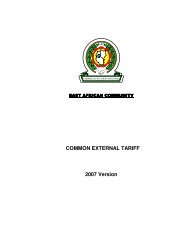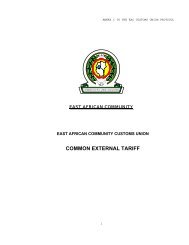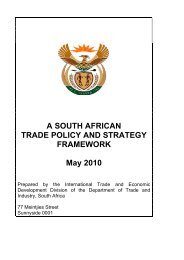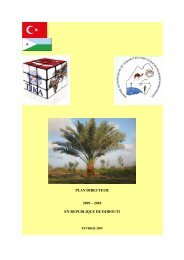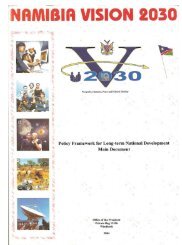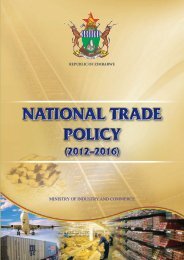Volume 1 - Government of Botswana
Volume 1 - Government of Botswana
Volume 1 - Government of Botswana
You also want an ePaper? Increase the reach of your titles
YUMPU automatically turns print PDFs into web optimized ePapers that Google loves.
2.5 This paradigm shift reflects the<br />
recognition that population as a factor and a<br />
beneficiary <strong>of</strong> development is central to social<br />
and economic planning and, therefore, must be<br />
integrated into the mainstream development<br />
planning process. As a result, <strong>Government</strong><br />
adopted a comprehensive, multi-sectoral<br />
National Population Policy in 1997. The Policy<br />
provides a framework to ensure that the<br />
dynamics <strong>of</strong> population and development are<br />
taken into account in mapping out long term<br />
prospects. Since the impact <strong>of</strong> policies and<br />
programmes cannot be evaluated realistically<br />
within the medium-term time frame, a long<br />
term planning perspective, such as Vision<br />
2016, is necessary. The National Population<br />
Policy has been reviewed to align it with the<br />
latest developments, including the MDGs.<br />
2.6 In 2000, the <strong>Government</strong> <strong>of</strong><br />
<strong>Botswana</strong>, along with other governments,<br />
signed the Millennium Declaration. Most<br />
importantly, the declaration committed<br />
<strong>Botswana</strong> to alleviating extreme poverty and<br />
its related socio-economic problems. The<br />
Declaration commits countries to achieve<br />
eight goals by 2015. These include:<br />
“eradicating extreme poverty and hunger”;<br />
“achieving universal primary education”;<br />
“promoting gender equality and empowering<br />
women”; “reducing child mortality”;<br />
“improving maternal health”; “combating<br />
HIV/AIDS, malaria and other diseases”;<br />
“ensuring environmental sustainability”; and<br />
“developing global partnerships for<br />
development.”<br />
2.7 The resource needs to achieve these<br />
goals are substantial. The 2005 United<br />
Nations World Summit <strong>of</strong> the Millennium<br />
Development Goals recognised this challenge<br />
and called on countries to “develop and adopt<br />
by 2006, and implement comprehensive<br />
national development strategies to achieve the<br />
internationally agreed development goals and<br />
objectives, including the Millennium<br />
Development Goals.” <strong>Botswana</strong> has<br />
undertaken a detailed inventory <strong>of</strong> the full<br />
range <strong>of</strong> public interventions and investments<br />
needed to meet or exceed the MDGs, along<br />
with the associated costs <strong>of</strong> doing so, and<br />
the most feasible way <strong>of</strong> financing these<br />
interventions. This MDG needs assessment<br />
and costing exercise is, therefore,<br />
fundamentally about the meaningful<br />
integration <strong>of</strong> MDGs into National<br />
Development Plan 10 to ensure that<br />
<strong>Botswana</strong> accelerates progress to achieve<br />
both the National Vision 2016 objectives<br />
and MDG goals. Some details <strong>of</strong> the<br />
progress made with respect to the MDGs are<br />
provided in the following section.<br />
PROGRESS TOWARDS THE<br />
MILLENNIUM DEVELOPMENT<br />
GOALS (MDGS)<br />
2.8 The MDGs to be achieved by 2015<br />
overlap considerably with the goals <strong>of</strong><br />
Vision 2016. The report <strong>of</strong> <strong>Botswana</strong>'s<br />
Millennium Development Goals Based<br />
Strategies has provided estimates <strong>of</strong> the cost<br />
<strong>of</strong> the programmes needed to reach the<br />
MDGs. These have been incorporated into<br />
National Development Plan 10 to the extent<br />
possible, given the public expenditure<br />
strategy adopted on the basis <strong>of</strong> the<br />
government revenue that will be available<br />
during NDP 10 (see Chapter 6). Progress<br />
towards the MDGs includes the following:<br />
• Eradicate extreme poverty and hunger.<br />
The proportion <strong>of</strong> people living below<br />
the Poverty Datum Line fell from 49<br />
percent in 1993/94 to 30 percent in<br />
2002/03, and is estimated to have<br />
declined further to 23 percent by the end<br />
<strong>of</strong> NDP 9. The percentage <strong>of</strong> children<br />
under the age <strong>of</strong> five, who were<br />
underweight for age, was reduced from<br />
12.4 percent in 2000 to 4 percent in<br />
2006.<br />
• Universal primary education. In 2004, the<br />
net enrolment rate for the primary school<br />
age group, those between 7 and 13 years,<br />
was 98.5 percent. The Ministry <strong>of</strong><br />
Education and Skills Development<br />
16



